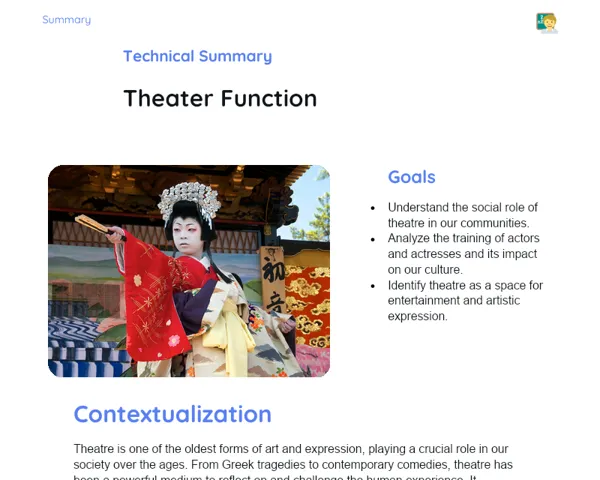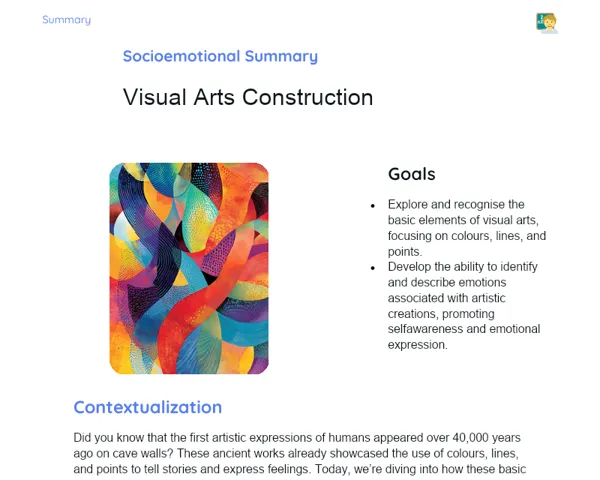Socioemotional Summary Conclusion
Goals
1. Gain an understanding of the role of art in ancient Mesopotamian society, recognising its key characteristics and cultural impacts.
2. Identify and analyse the mythological representations and architectural marvels of Mesopotamia, appreciating how these artistic expressions influenced the cultural identity of this remarkable civilisation.
Contextualization
Ancient Mesopotamia, often referred to as the land between rivers, was a rich tapestry of incredible artistic expression. Picture a society where the gods seemed omnipresent, their stories sculpted in stone and formed in clay to honour their deeds. Let’s explore how each piece of art reveals the emotions, beliefs, and values of the people who laid the groundwork for our shared history!
Exercising Your Knowledge
Mesopotamian Art
The art of Mesopotamia is a vibrant reflection of the culture and emotions of its people. This includes sculptures, reliefs, grand architecture, and decorative items, making it one of the earliest documented artistic traditions. For the Mesopotamians, art was not just for beautification; it was a means of expressing their religious, political, and social ideologies.
-
🗿 Sculptures and Reliefs: These art forms often depicted deities, monarchs, and legendary heroes, crafted with great attention to detail to tell stories and preserve the memories of important figures.
-
🏛️ Monumental Architecture: Structures like ziggurats exemplified not only technical prowess but also symbolised the connection between the earthly and the divine, showcasing the centrality of religion in day-to-day life.
-
🏛️ Social and Political Role: Mesopotamian art played a crucial role in reinforcing power, frequently portraying rulers in commanding poses, accompanied by symbols of authority and divinity.
Mythological Representations
Mythological depictions in Mesopotamian art illuminated the stories of gods and heroes that were central to their collective psyche. These narratives were deeply ingrained in their culture and served to interpret natural events, validate governing systems, and convey moral lessons.
-
🏛️ Myths and Deities: Characters like Gilgamesh were illustrated in various artistic forms, creating a tangible link to the legendary tales that shaped Mesopotamian identity.
-
🌌 Emotional Symbolism: Mythological art captured complex feelings such as awe, reverence, and devotion, providing narratives that offered solace and understanding amidst life's uncertainties.
-
📚 Educational Purpose: These stories of courage, justice, and sacrifice served as educational narratives, instilling moral values in younger generations.
Mesopotamian Architecture
Ancient Mesopotamian architecture represents some of humanity's most remarkable achievements, showcasing both innovation and social structure alongside deep-seated religious beliefs. Monumental edifices like ziggurats were pivotal in both spiritual and communal life.
-
🌟 Ziggurats: These pyramid-shaped temples acted as conduits between humans and the divine, highlighting the core role of religion in Mesopotamian existence.
-
🏗️ Planned Cities: The meticulous layout of streets and advanced irrigation systems in Mesopotamian cities reflected a sophisticated level of social and political organisation.
-
🧱 Technical Advancements: Utilising clay bricks and innovative building methods, the Mesopotamians created resilient structures, representing a significant leap in engineering for their time.
Key Terms
-
Mesopotamian Art
-
Mythological Representations
-
Mesopotamian Architecture
-
Cylinder Seals
-
Sculpture
-
Religion
-
Ziggurats
-
Cultural Heritage
For Reflection
-
In what ways did Mesopotamian art shape the cultural and religious identity of its people?
-
What emotions do you believe the Mesopotamians aimed to express and sustain through their sculptures and structures?
-
Consider how mythological representations offer a means for societies to navigate emotional and social challenges.
Important Conclusions
-
The art of Mesopotamia is amongst the earliest documented forms of creativity, reflecting the religious, political, and social ideologies of its timeframe.
-
Mythological depictions brought the tales of gods and heroes to life, explaining natural events and conveying societal values.
-
The architecture of Mesopotamia, particularly structures like ziggurats, exemplified the bond between the earthly and the divine, playing a vital role in both religious practices and community life.
Impacts on Society
The legacy of Ancient Mesopotamian art resonates in modern society in diverse ways. Firstly, it enriches our understanding of the foundations of civilisations and the evolution of artistic expressions through the ages. By studying their mythological art and architecture, we can appreciate the cultural depth and emotional complexity of ancient societies and draw inspiration from their techniques and innovations for our own creative and architectural practices.
Moreover, fostering an emotional connection with these artworks and a deeper understanding of Mesopotamian values enhances our empathy and respect for cultural diversity. By recognising that feelings like devotion, fear, and admiration are universal and manifest in various forms across history, we cultivate a broader social consciousness and improve our communication and collaboration skills in today's world.
Dealing with Emotions
To navigate your feelings while studying Mesopotamian art and its implications, I suggest an exercise based on the RULER method. Start by taking a few moments to identify and label the emotions you experience while exploring this subject: curiosity, admiration, frustration, perhaps? Next, ponder the reasons for these feelings and their impact on your learning journey. Consider expressing these emotions through drawing, creative writing, or engaging in conversation with a classmate. Lastly, manage these emotions through relaxation techniques or strategic breaks to maintain focus and motivation in your studies.
Study Tips
-
Dedicate a few minutes each day to practicing creative visualisation, putting yourself in ancient Mesopotamia and experiencing the emotions of that era.
-
Watch videos and documentaries about Mesopotamian art and architecture to enhance your study and bring the discussed structures and artworks to life.
-
Maintain a visual or written journal to record your discoveries, emotions, and insights about Mesopotamian art, which will help reinforce your learning.



